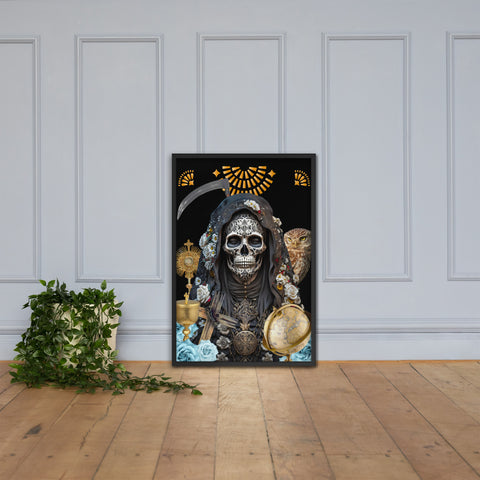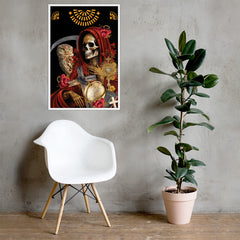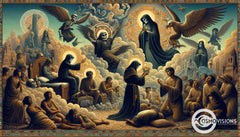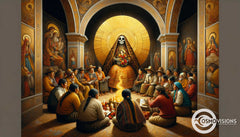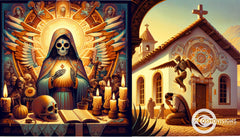Exploring the Intersection of Santa Muerte and Religion in Mexican Culture
Posted by Luciano Martucci
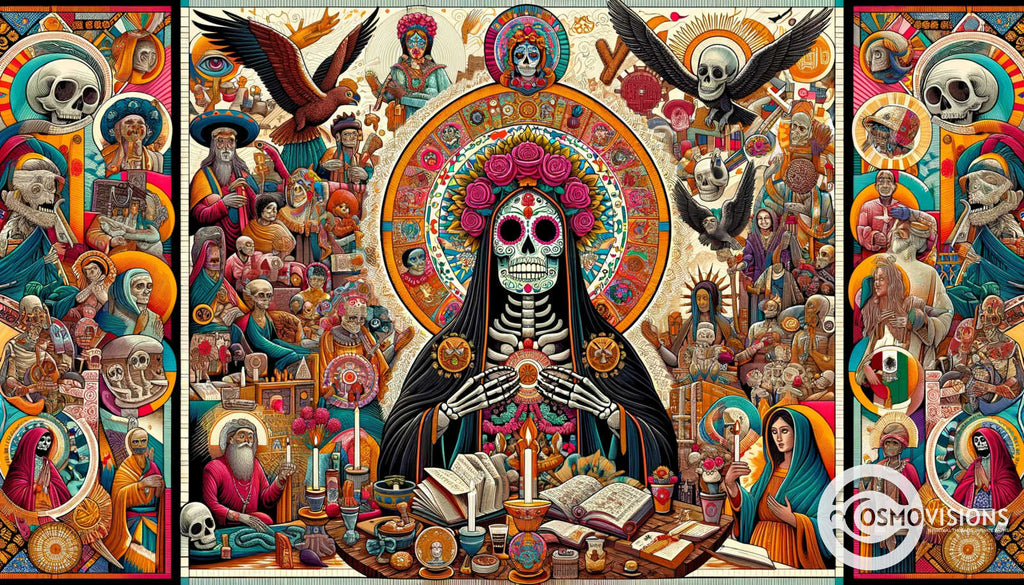
In the vibrant tapestry of Mexican culture, there exists a mysterious figure shrouded in both devotion and controversy: Santa Muerte. Often misunderstood, this folk saint captures the imagination and stirs deep feelings across communities.
Perhaps you've felt a pull to explore beyond mainstream religion or you're simply curious about how different belief systems merge into unique spiritual practices.
Santa Muerte stands as a striking symbol where indigenous traditions intertwine with Catholicism, reflecting an unorthodox blend that has captured hearts and provoked debate. This blog promises to guide you through the fascinating interplay of faith surrounding "Saint Death," shedding light on her significance in Mexico’s religious landscape.
Discover how this powerful entity influences lives, often reaching out to those on society's fringes who seek solace or protection.
Get ready for a journey into the heart of Mexican spirituality!
Understanding Santa Muerte
Santa Muerte, also known as "Saint Death," is a revered figure in Mexican culture with a rich history and unique attributes. Understanding the iconography, origins, and veneration of Santa Muerte provides insight into its significance in Mexican spirituality.
Names and Iconography
The skeletal figure of Santa Muerte, draped in long robes and wielding a scythe, merges Precolumbian beliefs with European influence. Followers often call her "La Flaquita," the Skinny Lady, or "La Niña Blanca," the White Girl, reflecting her bone-chilling appearance.
She embodies death personified yet resonates deeply with life's daily struggles for many believers.
Iconography plays a critical role in how devotees connect with this saint of death. Colorful statues and images depict her holding globes, scales, and oil lamps — symbols borrowed from Catholic and indigenous traditions alike.
Each color of her robes signifies a distinct aspect or offering: red for love magic; white for purity; green symbolizes justice. This fusion creates a unique visual language that speaks to those living at society's edges while echoing ancient Mesoamerican rituals blended with folk Catholicism.
History and Origins
Santa Muerte's past is a tapestry of mystery and cultural fusion. Indigenous beliefs often hold that she has roots in ancient Aztec customs, where the goddess Mictecacihuatl presided over festivities honoring the dead.
Yet, some historians suggest that European colonization brought similar figures of death which merged with local traditions to form what we know today as Santa Muerte. This blend reflects the syncretic nature of this spiritual phenomenon, marrying elements from both Native Mexican spirituality and imported Catholicism.
Her worship has evolved significantly since those early days, adapting to contemporary social issues and personal hardships. Followers seek her protection and favor across diverse areas such as love, health, money-making endeavors—and even safe passage for undocumented migrants or justice for those treated unfairly by society's conventional structures.
As devotees light votive candles in prayerful rituals beneath her watchful eye, they continue a practice shaped by centuries-old legacies now deeply embedded in Mexican culture. Moving forward into "Attributes and Veneration," these practices reveal the profound impact Santa Muerte has on everyday life throughout Mexico.
Attributes and Veneration
Tracing her roots through a complex blend of cultures, Santa Muerte embodies attributes resonating with devotees from various backgrounds. Followers often depict her holding a globe, symbolizing power over the world, and a scythe to represent justice and the cutting of negative energies.
She appears as a skeleton clad in colorful robes, combining elements of Precolumbian death deities with Catholic iconography.
Devotees show their reverence by setting up altars in her honor where they offer candles, flowers, fruits, cigarettes or even tequila. The practice reflects an amalgamation of indigenous traditions and folk Catholicism tailored to individual needs for protection and blessings.
La Santa Muerte's followers pray to her for miracles ranging from healing sickness to ensuring safe passage through dangerous journeys. Her veneration is deeply personal; it speaks not only to spiritual desires but also to social realities faced by worshippers navigating life's uncertainties.

Santa Muerte and Mexican Culture
Associated with rituals, places of worship, and votive candles, Santa Muerte plays a significant role in Mexican culture. Understanding the cultural significance of this figure is crucial for gaining insight into the intersection of religion and spirituality in Mexico.
Associated Rituals
The rituals associated with Santa Muerte play a significant role in the veneration of this deity. Followers perform various rituals involving offerings to Santa Muerte as a way of seeking protection, guidance, and aid. These rituals are deeply rooted in Mexican culture and are often performed by marginalized communities as a means of finding solace and empowerment.
- Offering of candles: Devotees light colorful candles representing different aspects such as love, health, or prosperity as an offering to Santa Muerte.
- Prayers and petitions: Followers recite prayers and make specific requests to Santa Muerte for assistance in their personal or spiritual matters.
- Ritualistic items: Offerings include symbolic items such as flowers, fruits, tobacco, incense, and alcoholic beverages that hold cultural significance.
- Ceremonial gatherings: Rituals may involve organized gatherings where devotees come together to honor Santa Muerte through collective prayers, music, and dance.
- Personal altars: Many followers create personal altars within their homes adorned with images of Santa Muerte where they conduct daily devotional practices.
Places of Worship
Devotees of La Santa Muerte gather at street-side shrines adorned with vibrant altars, paying homage to the skeletal figure of death clad in various robes representing different aspects and intentions.
These makeshift places of worship can be found across Mexico City, where candles flicker alongside offerings like flowers, cigarettes, liquor, and even candy. The cult's followers believe these items attract the saint's favor and assistance in their daily lives.
The eclectic blend of beliefs surrounding Santa Muerte's veneration reflects a syncretic fusion of Catholicism with indigenous traditions and diverse folk beliefs.
Votive Candles
In the context of Santa Muerte worship, votive candles are integral to the expression of devotion and supplication. These candles hold symbolic significance, with devotees using different colors to convey specific intentions.
White votive candles represent purity and protection and are commonly used in petitions for blessings or guidance. On the other hand, black votive candles signify requests for retribution or harm in the sphere of Santa Muerte veneration.
This practice reflects the syncretic nature of this religious movement, rooted in Mexican culture.

Miracles of Santa Muerte
Santa Muerte is believed to perform miracles for her devotees, fulfilling their requests and offering assistance in times of need. Many followers attribute healings, financial windfalls, and even protection from violence to the intervention of Santa Muerte.
The skeleton saint has garnered a reputation for answering prayers and providing guidance in difficult situations. Her devotees often express gratitude through offerings of flowers, food, and candles at her shrines as tokens of thanks for the miracles they believe she has bestowed upon them.
These acts of veneration reflect the deep faith and reverence that many hold for Santa Muerte.
The cult of Santa Muerte continues to grow as her perceived ability to work miraculous interventions draws more worshippers seeking help with various aspects of their lives. Whether it is health issues, legal problems, or matters related to love and relationships, people from diverse backgrounds have turned to Santa Muerte in search of aid in desperate situations.
Role of Santa Muerte in Society
Santa Muerte plays a significant role in Mexican society, particularly among the marginalized and disenfranchised. It is associated with the LGBTQ+ community and has been linked to criminal activities, but it also provides comfort and support for those on the fringes of society.
Association with the LGBTQ+ community
Santa Muerte plays a significant role in the LGBTQ+ community, serving as a protector and symbol of acceptance for homosexual, bisexual, and transgender individuals. It is not uncommon for Santa Muerte to be invoked during same-sex marriage ceremonies in Mexico, reflecting its association with diverse expressions of love and relationships.
Furthermore, there's a network of LGBTQ leaders who sustain and organize La Santa Muerte worship in Mexico, which highlights the bond between this deity and marginalized communities.
The growing devotion among Mexican transgender persons underlines the widening gap between LGBT individuals and traditional religious establishments.
The queer performance scene and studies within the realm of religion emphasize how Santa Muerte has become an important figure for promoting inclusivity within the LGBTQ+ community.
Association with criminality
Given the association of Santa Muerte with the LGBTQ+ community, it's crucial to address another significant but controversial aspect linked to this religious figure. Some individuals have connected Santa Muerte worship with criminality, particularly in relation to a variant of the cult that promotes higher levels of criminal activity.
Although there is no consensus on the extent and importance of the criminal sector within the Santa Muerte worship community, some believe that its worship has contributed to increased crime rates, as noted by a Mexican exorcist.
The image of Santa Muerte is predominantly associated with criminality, often linked to narco-related activities. This association can sometimes be traced back to the Aztec gods of death and the underworld, adding complexity and diversity to Santa Muerte's religious and cultural significance in Mexican society.

Opposition and Persecution
The opposition to Santa Muerte by the Church and the state has led to persecution, including legal battles and attempts to shut down places of worship. Despite this resistance, devotion to Santa Muerte continues to grow among those who feel marginalized by mainstream religion.
Church Opposition
The cult of Santa Muerte faces fierce opposition from the Catholic Church. The church views her veneration as blasphemous and satanic, condemning the skeleton saint for her association with the lower classes and criminal elements in Mexican society.
Santa Muerte's controversial status is further exacerbated by her strong following among those on the margins of society. Despite not being officially recognized by the Catholic Church, Santa Muerte continues to be revered fervently, posing a challenge to traditional religious authority.
State Opposition
The Catholic Church in Mexico actively opposes the worship of Santa Muerte. This opposition stems from the skeleton saint's embodiment of defiance against both church and state, making it a divisive element in Mexican society.
Santa Muerte's strong association with lower classes and criminal elements has led to persecution and condemnation by the Catholic Church, contributing to its estranged relationship with both the church and the state throughout history.
This contentious dynamic has contributed to periods of hostility between Santa Muerte worshippers and authorities, shaping its role as a subversive force within Mexican culture.—Santa Muerte: Saint of the Dispossessed, Enemy of Church and State
Santa Muerte: Saint of the Dispossessed, Enemy of Church and State
Santa Muerte, known as the Saint of the Dispossessed, is seen as an enemy of both church and state due to its subversive nature and opposition to traditional religious and societal norms.
This powerful figure has gained a following among marginalized communities and continues to challenge the authority of established institutions.
The Subversive Saint
Santa Muerte is regarded as a subversive figure, challenging the authority of both the church and the state in Mexican culture. This controversial saint is perceived to be an adversary of traditional religious and political institutions, with widespread opposition from both Cardinal Ravasi who associates worshiping Santa Muerte with God's enemies, death, and Satan, as well as the government declaring her an enemy of the state.
The veneration of Santa Muerte stands in direct contrast to established religious and political beliefs, making her a symbol of defiance against societal norms. The contentious nature of this saint has sparked extensive debate within Mexican culture regarding her role and impact on traditional practices.
Land Acknowledgement
Santa Muerte has deep ties to the dispossessed in Mexican culture, particularly those marginalized from their ancestral lands. The veneration of Santa Muerte intersects with indigenous beliefs and folk Catholicism, reflecting a profound connection to the land and its spiritual significance.
As the fastest-growing religion in the Americas, the worship of Santa Muerte significantly impacts cultural and spiritual landscapes, including its relationship to the land. Widely revered as a protector for those on society's margins, she is not viewed as a symbol of Satanism but rather as an essential divine worker under God’s guidance.
With her association with security and protection for the marginalized or displaced, there exists a complex understanding of spirituality that reflects reverence toward both natural elements such as land and human experiences."
La Santa Muerte: Mexico’s Macabre Religion at Odds with the Church
La Santa Muerte, also known as "Saint Death," has faced opposition from the Catholic Church due to its association with death and the afterlife. The complex origins of La Santa Muerte and its rise to popular attention in the 1990s have made it a controversial figure within Mexican culture.
The Complex Origins of La Santa Muerte
La Santa Muerte has complex origins deeply intertwined with Mexican culture and history. Originating from indigenous Mesoamerican beliefs, the cult of Holy Death also draws on European Catholic traditions brought by Spanish conquistadors.
Over time, La Santa Muerte evolved into a syncretic faith blending pre-Hispanic spirituality with folk Catholicism, reflecting the marginalized communities' embrace of death as a part of life.
This fusion created an enigmatic figure that embodies both devotion and fear in Mexican society.
As we delve deeper into La Santa Muerte's intricate origins, it becomes evident that her multifaceted nature represents a response to societal complexities, serving as an instrument for empowerment among those at the margins.
These origins underscore how this macabre religious figure has become a symbol of resistance against social injustices and historical struggles unique to Mexico.
Rise to Popular Attention in the 1990s and Beyond
La Santa Muerte experienced a surge in popularity and visibility during the 1990s, becoming one of the fastest-growing religions across the Americas. This rise to prominence challenged traditional religious norms, drawing followers from diverse backgrounds beyond just Hispanic and Latino communities.
The controversial ascent of Santa Muerte brought it into direct conflict with the Catholic Church in Mexico. As widespread attention increased, so did controversy surrounding this enigmatic figure.
The 1990s marked a turning point for La Santa Muerte's public perception as it garnered attention not only within Mexican culture but also beyond its borders. The appeal of La Santa Muerte was propelled by societal shifts and has since engaged followers across different social spheres, causing significant tension with established religious entities.
Who Reveres La Santa Muerte?
Many marginalized communities in Mexico and the United States, including LGBTQ+ individuals, sex workers, and those involved in drug trafficking, revere La Santa Muerte. Despite being condemned by the Catholic Church, this subversive saint has attracted a diverse following seeking protection and guidance.
What Does the “Bony Lady” Do?
La Santa Muerte, known as the “Bony Lady,” is revered for her ability to perform miracles and offer protection to her devotees. People seek her intercession in their daily lives, believing that she has the power to grant their requests.
She is depicted in various forms such as statues and altars, symbolizing different aspects of life and death. Her followers consider her sacred and rely on her assistance during challenging times.
La Santa Muerte holds a significant place in Mexican popular religion, with devotees looking up to her for guidance and support.
La Santa Muerte's association with Mexican folk beliefs aligns with the reverence of death as part of life. Her role underscores the interconnectedness between life and death within Mexican culture, resonating deeply with those seeking solace, protection, or hope amidst adversity.
What Does the Catholic Church Think of “Saint Death?”
The Catholic Church views "Saint Death" with intense disapproval, considering the veneration of Santa Muerte as heretical and blasphemous. The church has repeatedly condemned the figure for being associated with criminality, labeling it as a symbol of moral decay and deviance.
Despite efforts to suppress its influence, including emphasizing the popularity of other saints such as St. Jude, la Santa Muerte's rise in Mexico continues unabated.
Canonical figures in the Roman Catholic Church have endeavored to diminish Saint Death's significance by focusing on the adoration of established saints like La Virgen de Guadalupe and San Judas Tadeo, attempting to counteract Saint Death’s appeal among Mexican believers.
La Santa Muerte: Fighting for People on the Margins
La Santa Muerte stands as a powerful figure for marginalized communities, including Mexican expats and their families. This unconventional religious movement revolves around the folk saint of death, embracing both Catholic and indigenous elements.
In contrast to the iconic Catrina, La Santa Muerte symbolizes controversy and allure within popular Mexican imagery.







